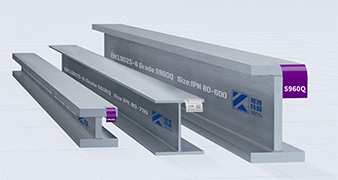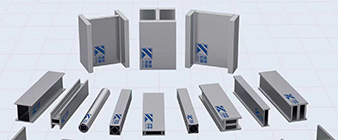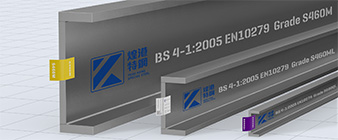Grade 310 (1.4845) Stainless Steel is an austenitic stainless steel that combines excellent high temperature properties with good ductility and weldability. It is typically used for elevated temperature applications as its high chromium and nickel content provide solid corrosion resistance, excellent resistance to oxidation, and superior strength in temperatures up to 2100°F. Due to its high chromium and nickel content, it is superior to 304 or 309 stainless in most environments.


The higher alloyed stainless steels generally have excellent strength at elevated temperatures along with outstanding resistance to creep deformation and environmental attack. Therefore, Alloy 310 is used widely in industries such as heat treatment and chemical processing. Some examples include:
- Furnace Parts
- Oil Burner Parts
- Heat Exchangers
- Welding Filler Wire and Electrodes
- Annealing Covers
- Combustion Tubes
- Fire Box Sheets
- Provides excellent corrosion resistance
- High chromium content allows for good aqueous corrosion resistance
- Excellent resistance at normal temperatures and also has good resistance to oxidizing and carburizing atmospheres
- Good resistance to oxidation in intermittent service in air at temperatures up to 1040°C and 1150°C in continuous service.
- Good resistance to thermal fatigue and cyclic heating.
- Widely used where sulphur dioxide gas is encountered at elevated temperatures.
- Continuous use in 425-860°C range not recommended due to carbide precipitation, if subsequent aqueous corrosion resistance is needed.
- Generally used at temperatures starting from about 800 or 900°C – above the temperatures at which 304H and 321 are effective.
- Commonly used in the heat treatment and process industries due to high temperature and corrosive environments.
- Often fabricated into complex structures.
- Roller-forms, stamps and draws readily Because 310 work hardens, severe forming operations should be followed by an anneal
- Austenitic stainless steel is generally considered to be weldable
- Generally considered to have weldability equivalent to 304 and 304L
- Special consideration is needed to compensate for a higher coefficient of thermal expansion to avoid warping and distortion
| Cr | Ni | C | Si | Mn | P | S | Mo | Cu | Fe | |
| 310 |
min: 24.0 max: 26.0 |
min: 19.0 max: 22.0 |
0.25 | 0.75 | 2.0 | 0.045 | 0.030 | 0.75 | 0.5 | balance |
| 310S |
min: 24.0 max: 26.0 |
min: 19.0 max: 22.0 |
0.08 | 1.00 | 2.0 | 0.045 | 0.030 | 0.75 | 0.5 | balance |
| Grade | Tensile Strength ksi (min.) | Yield Strength 0.2% Offset ksi (min.) | Elongation – % in 50 mm (min.) | Hardness (Brinell) MAX | Hardness (Rockwell B) MAX |
| 310/310S | 75 | 30 | 40 | 217 |
95 |
| Denstiy lbm/in3 | Coefficient of Thermal Expansion (min/in)-°F | Electrical Resistivity mW-in | Thermal Conductivity BTU/hr-ft-°F | Specific Heat BTU/lbm -°F | Magnetic Permability (annealed)1 | Modules of Elasticity (annealed)2-psi | |||||
|
at 68 °F |
at 68 – 212°F | at 68 – 932°F | at 68 – 1832°F | at 68°F | at 1200°F | at 68 – 1832°F | at 68 – 932°F | at 32 – 212° | at 200H | in tension (E) | in shear (G) |
| 0.29 | 8.8 | 9.5 | 10.5 | 30.7 | – | 10.5 | 10.8 | 0.12 | 1.02 | 29 x 10-6 | 11.2 x 10-6 |
-
 2024-7-19 Innovative Application of S960Q/S960QL/S960QL1 Structure steel
2024-7-19 Innovative Application of S960Q/S960QL/S960QL1 Structure steel -
 2024-9-20 2205 duplex stainless steel in water treatment industry applications
2024-9-20 2205 duplex stainless steel in water treatment industry applications -
 2024-9-19 Alloy 718/2.4668/UNS N07718 Hollow structural profile applications
2024-9-19 Alloy 718/2.4668/UNS N07718 Hollow structural profile applications -
 2024-9-24 310S stainless steel hollow structural Sections
2024-9-24 310S stainless steel hollow structural Sections -
 2024-9-16 Stainless Steel Structural Beam and Column
2024-9-16 Stainless Steel Structural Beam and Column -
 2024-9-25 SMO254 vs. 1.4547 Super Stainless Steel for Structural Applications
2024-9-25 SMO254 vs. 1.4547 Super Stainless Steel for Structural Applications -
 2024-7-11 Application of S690 Steel in Construction
2024-7-11 Application of S690 Steel in Construction



